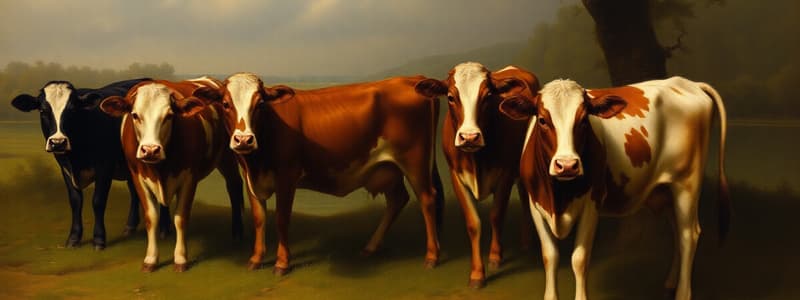Podcast
Questions and Answers
What is the primary aim of a commercial beef suckler herd?
What is the primary aim of a commercial beef suckler herd?
- Provide grazing for dairy cows
- Produce young stock destined for slaughter as a beef carcass (correct)
- Produce wool for textile manufacturing
- Produce high milk yields
Suckler cows are always bred using artificial insemination (AI).
Suckler cows are always bred using artificial insemination (AI).
False (B)
What is the typical weaning age for calves in a commercial beef suckler herd?
What is the typical weaning age for calves in a commercial beef suckler herd?
5-9 months
Feed costs account for ____% of total variable costs in beef cattle production.
Feed costs account for ____% of total variable costs in beef cattle production.
Match the following terms with their definitions:
Match the following terms with their definitions:
Which factor is NOT mentioned as affecting Body Condition Score (BCS)?
Which factor is NOT mentioned as affecting Body Condition Score (BCS)?
Calves born in autumn can require conserved forages.
Calves born in autumn can require conserved forages.
A compact calving season helps in managing ____ disease and mortality.
A compact calving season helps in managing ____ disease and mortality.
What is the daily weight loss for spring calvers in a 1 Body Condition Score (BCS) over the housing period?
What is the daily weight loss for spring calvers in a 1 Body Condition Score (BCS) over the housing period?
Autumn calvers lose weight only until they are in calf.
Autumn calvers lose weight only until they are in calf.
What is the target weight gain for cows during the grazing season to achieve 1 BCS?
What is the target weight gain for cows during the grazing season to achieve 1 BCS?
Young stock rearing units face high risk due to mixing and allowing exchange of __________.
Young stock rearing units face high risk due to mixing and allowing exchange of __________.
Which disease has a significant impact on the fattening units?
Which disease has a significant impact on the fattening units?
Match the feeding phases of beef cattle with their durations:
Match the feeding phases of beef cattle with their durations:
The diet during the finishing phase of beef cattle consists mostly of forage-based feed.
The diet during the finishing phase of beef cattle consists mostly of forage-based feed.
What pigment in green forage can affect the fat color of cattle?
What pigment in green forage can affect the fat color of cattle?
Which of the following is a primary sector in beef production?
Which of the following is a primary sector in beef production?
The Estimated Breeding Value (EBV) is used to indicate how much better or worse an animal is compared to the average animal in its breed.
The Estimated Breeding Value (EBV) is used to indicate how much better or worse an animal is compared to the average animal in its breed.
What is the primary purpose of pedigree breeding herds in the beef industry?
What is the primary purpose of pedigree breeding herds in the beef industry?
Approximately ______% of the beef consumed comes from dairy progeny.
Approximately ______% of the beef consumed comes from dairy progeny.
Match the following components with their descriptions:
Match the following components with their descriptions:
Which of the following traits related to breeding bulls has a positive Estimated Breeding Value (EBV) indication?
Which of the following traits related to breeding bulls has a positive Estimated Breeding Value (EBV) indication?
The maximum EBV index for a breeding bull is 100, which indicates the animal's average performance.
The maximum EBV index for a breeding bull is 100, which indicates the animal's average performance.
What is one factor that can increase the accuracy of the EBV for a bull?
What is one factor that can increase the accuracy of the EBV for a bull?
Flashcards
Commercial Beef Suckler Herd
Commercial Beef Suckler Herd
The process of raising cattle for the production of beef, typically involving breeding, raising calves, and eventually sending them to slaughter.
Suckler Cow
Suckler Cow
The phase of the beef production cycle where calves are born and raised by their mother.
Spring Born Calves
Spring Born Calves
Calves born in the spring, weaned at 5-9 months, and then either kept for breeding or sent to a finishing unit for fattening.
Autumn Born Calves
Autumn Born Calves
Signup and view all the flashcards
Compact Calving Season
Compact Calving Season
Signup and view all the flashcards
Fattening Animal
Fattening Animal
Signup and view all the flashcards
Nutrition of Growing Beef Animals
Nutrition of Growing Beef Animals
Signup and view all the flashcards
Body Condition Score
Body Condition Score
Signup and view all the flashcards
Spring Calvers Weight Loss
Spring Calvers Weight Loss
Signup and view all the flashcards
Autumn Calvers Weight Loss
Autumn Calvers Weight Loss
Signup and view all the flashcards
Dairy Cow Weight Gain
Dairy Cow Weight Gain
Signup and view all the flashcards
BCS Mid-Season Check
BCS Mid-Season Check
Signup and view all the flashcards
Penn State BCS Method
Penn State BCS Method
Signup and view all the flashcards
Young Stock Rearing Units
Young Stock Rearing Units
Signup and view all the flashcards
Fattening Units
Fattening Units
Signup and view all the flashcards
Beef Cattle Feeding Phases
Beef Cattle Feeding Phases
Signup and view all the flashcards
What are the 4 main sectors of the UK beef industry?
What are the 4 main sectors of the UK beef industry?
Signup and view all the flashcards
What is the role of pedigree breeding herds?
What is the role of pedigree breeding herds?
Signup and view all the flashcards
What is an EBV?
What is an EBV?
Signup and view all the flashcards
How are EBVs calculated?
How are EBVs calculated?
Signup and view all the flashcards
What does a higher EBV mean?
What does a higher EBV mean?
Signup and view all the flashcards
For what traits can EBVs be calculated?
For what traits can EBVs be calculated?
Signup and view all the flashcards
How can you predict the impact of EBVs on the offspring of the animal?
How can you predict the impact of EBVs on the offspring of the animal?
Signup and view all the flashcards
Where does a significant portion of the beef in the UK come from?
Where does a significant portion of the beef in the UK come from?
Signup and view all the flashcards
Study Notes
Beef Cattle Industry
- The UK beef sector is described.
- The annual management cycle of UK beef cattle is outlined.
- Importance of nutrition, body condition scoring and breeding management for the UK beef industry.
- Value of beef animals is estimated.
- Important husbandry protocols are described.
- Different types of beef production systems are detailed.
- Key components of beef cattle husbandry are described.
Learning Objectives
- Students should be able to describe the structure of the UK beef sector by the end of the lecture.
- They should be able to describe the annual management cycle.
- Students should be able to indicate the importance of nutrition, body condition scoring and breeding management.
- They should be able to estimate the value of beef animals.
- Students should be able to describe important husbandry protocols.
- They should be able to describe the different types of beef production systems.
- Students should be able to describe the key components of beef cattle husbandry.
Breed Distribution
- Black & White (and cross) cattle make up 34% of the beef eaten in the UK.
- Limousin and cross cattle represent 21% of the beef consumed in the UK
- Other breeds make up 8% of the UK beef consumption
- South Devon and Blonde D'Aquitaine and cross cattle make up 2%
- Hereford and cross cattle make up 4%
- Belgian Blue and cross cattle represent 5%
- Aberdeen Angus and cross cattle represent 7%
- Simmental and cross cattle represent 8%
- Charolais and cross cattle make up 10%
- Data available suggests 50% of consumed beef comes from dairy progeny.
Beef Production Sectors
- Pedigree breeding herds produce breeding bulls and high-value breeding stock for commercial beef and dairy herds.
- Commercial beef suckler herds produce young stock for slaughter.
- Young stock rearing units are responsible for raising calves to suitable weights for fattening.
- Fattening units house animals that are gradually transitioned onto a high concentrate diet, before slaughter.
Pedigree Breeding Herds
- Aim to produce breeding bulls and high-value breeding stock.
- Used in commercial beef and dairy herds to breed and rear animals for slaughter.
- Performance records of cattle used to calculate Estimated Breeding Values (EBVs).
- High EBV means better performing animals than average for the herd/breed.
- Accuracy of EBV based on availability of data/performance records for that individual animal.
- Index score of 100 equals breed average.
- Index of 130 and above means that animal is in top 1% of a given breed.
Available Beef EBVs
- Birth weight, Calving Ease, Maternal, Calving ease, Gestation length, Calving value, 200 day weight, 400 day weight, Muscle depth, Fat depth, Lean Beef Value, Scrotal circumference, 200 day milk.
Lifecycle of Dairy Cows
- Close-up cow, Pre-weaning calf, Weaned calf, Breeding heifer, Store animal, Fattening animal
Commercial Beef Suckler Herds
- Herds specifically for calf production.
- Typically use natural mating practices with bulls.
- Keep some calves as replacements for herd.
- Others are sent to fattening units.
- Aim is often to produce one calf per cow per year.
- Spring or autumn calving.
- Based on seasonal grazing.
- Calves weaned in Autumn (or Spring).
- Needs conserved forages, bedding.
- Calves weaned at turnout or over the summer.
- Systems need adequate labor during calving periods.
- Aim for a compact calving season.
- Easier calf management at same age.
- Hevier calves at weaning.
Nutrition of Beef Animals
- Feed costs constitute 75% of total variable costs
- Extensive use of grazing in the UK beef industry.
- Lower milk yield results in reduced output and inputs.
Nutrition of Growing Beef Animals
- Dry matter intake 2-2.5% of liveweight dependent on cattle type.
- Target daily liveweight gain 0.7-1.2 kg.
- Metabolisable energy 10.5 to 11.5 MJ ME/Kg DM
Nutrition of Finishing Beef Animals
- Dry matter intake 1.7 to 2.0% liveweight.
- Target daily liveweight gain > 1.3 kg.
- Metabolisable energy > 12 MJ ME/kg DM
- Starch and sugar > 20% in dry matter.
- Crude protein 12-14%
- Overall, feeding rations require to be tailored to each animal.
- Age at slaughter affects meat toughness.
Nutrition of Suckler Cows
- Dry matter intake 13-16kg.
- Energy (ME MJ/day) dependent on stage & individual cow.
- Minimum crude protein 11-12% in dry matter
Body Condition Scores
- BCS 3.0 assumed for winter feeding.
- Spring calvers lose .5kg/day in BCS across housing.
- Autumn calvers lose .25kg/day until calving and 0.5 kg/day after.
- BCS mid-season to aid identification of problem cows.
- UK cattle needs gaining 100kg (1BCS) in grazing season.
- Problems associated with too thin or too fat cows.
Carcase Grading
- Good conformation increases high-value lean meat.
- Double muscled breeds have an advantage.
- Over-fat carcases have higher feed and downgrading costs.
- Aim for EUROP grading (E, U, R or 3 or 4L)
Animal Cleanliness at Slaughter
- EC Regulations 853/2004 (H2), 854/2004 (H3) dictate cattle cleanliness standards.
- Dirty hides hinder slaughtering and pose unacceptable risks of contamination.
- 5 categories of hide cleanliness.
Injections Techniques in Cattle
- Proper technique is essential for safety & meat quality.
- Visible injection sites, Injection knots, Infected sites & Abscesses.
- 4.1% prevalence of UK carcases with injection issues.
Vaccinations in Beef Cattle
- Vaccinations against clostridial diseases, BVD, Leptospirosis and IBR.
Calf Surgical Procedures
- Castration is a common veterinary procedure performed on male livestock, primarily to prevent unwanted breeding and to improve meat quality. There are various methods of castration, including rubber ring application, also known as banding, which is a less invasive technique, and surgical or open techniques that involve removing the testicles through an incision. Each method has specific indications based on the animal's age, health status, and the farm's management practices.
- DEFRA codes of welfare regarding treatments to be performed
- Anaesthetic must be used for animals aged over 2 months.
Disbudding
- Chemicals or surgical methods for young cattle disbudding.
- DEFRA (Department for Environment, Food & Rural Affairs) has established welfare codes that provide guidelines for the disbudding of cattle. These codes emphasize the importance of minimizing pain and distress during the procedure. The guidelines recommend that disbudding should be carried out by trained professionals and under appropriate anaesthesia to ensure the animal's welfare is maintained. Additionally, it is crucial to monitor the animals post-procedure for any signs of distress or complications. Regular assessments and adherence to best practices in animal care are essential for maintaining high welfare standards during disbudding.
Young Stock Rearing Units
- Calves acquired from dairy sector.
- Young cattle have variable resilience and are at risk mixing.
- High risk of pathogen exchange due to mixing.
- Biosecurity very difficult to maintain.
- Rearing relies on biocontainment to combat issues.
Fattening Units
- Take young stock from suckler herds and rearing units.
- Cattle must be resilient to diseases.
- Husbandry and early disease detection minimizes disease impact.
- Chronic disease less relevant to cattle.
- Cattle have 4 main phases of feed; backgrounding, transition, growing, & finishing.
- Transition gradually from forage to high concentrate to reduce acidosis risk.
- Fibre often fed separately.
- Aim is to maximise the rate of liveweight gain, to maximise market specification.
Studying That Suits You
Use AI to generate personalized quizzes and flashcards to suit your learning preferences.




